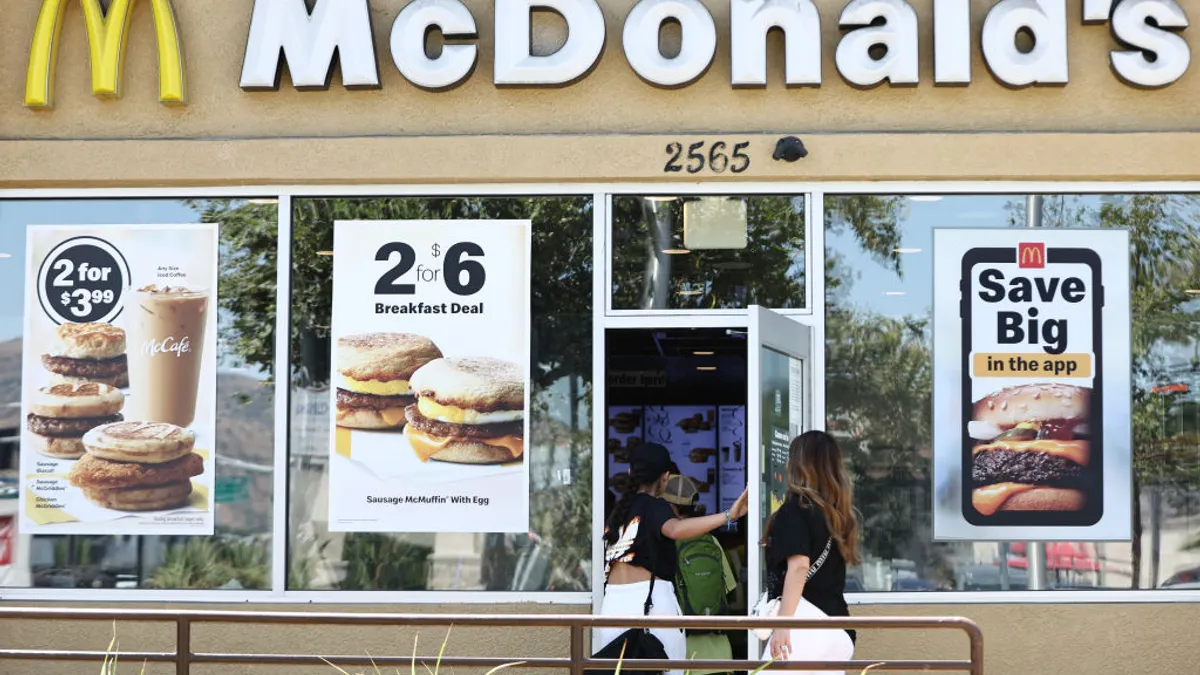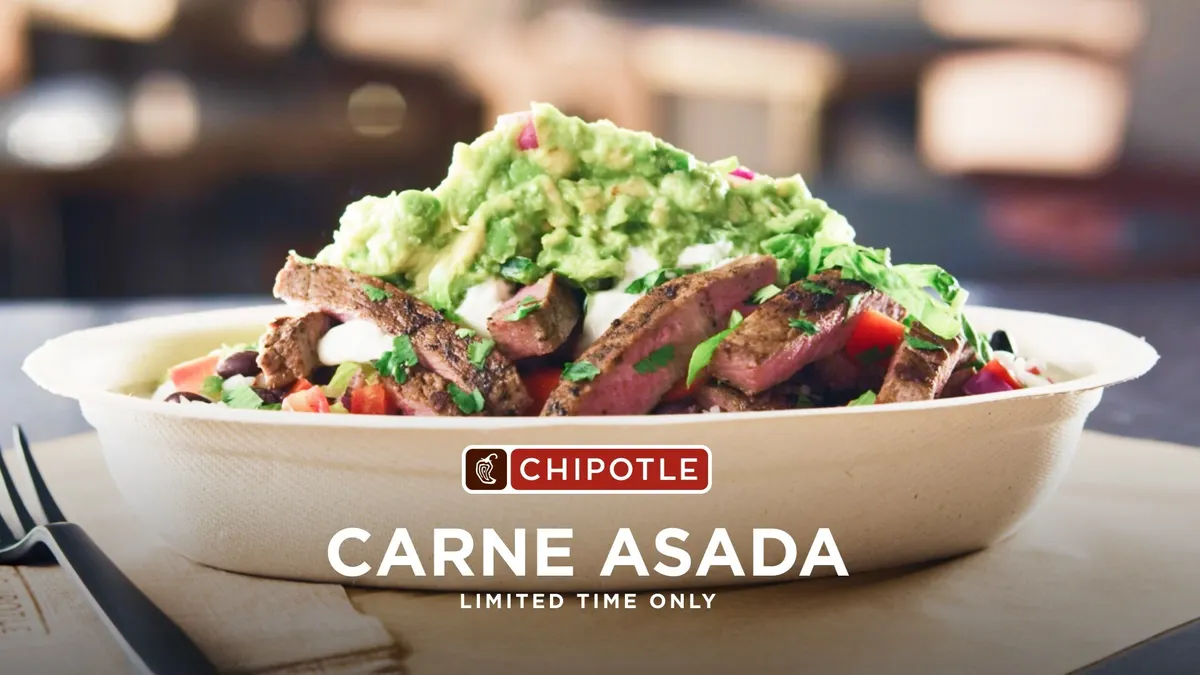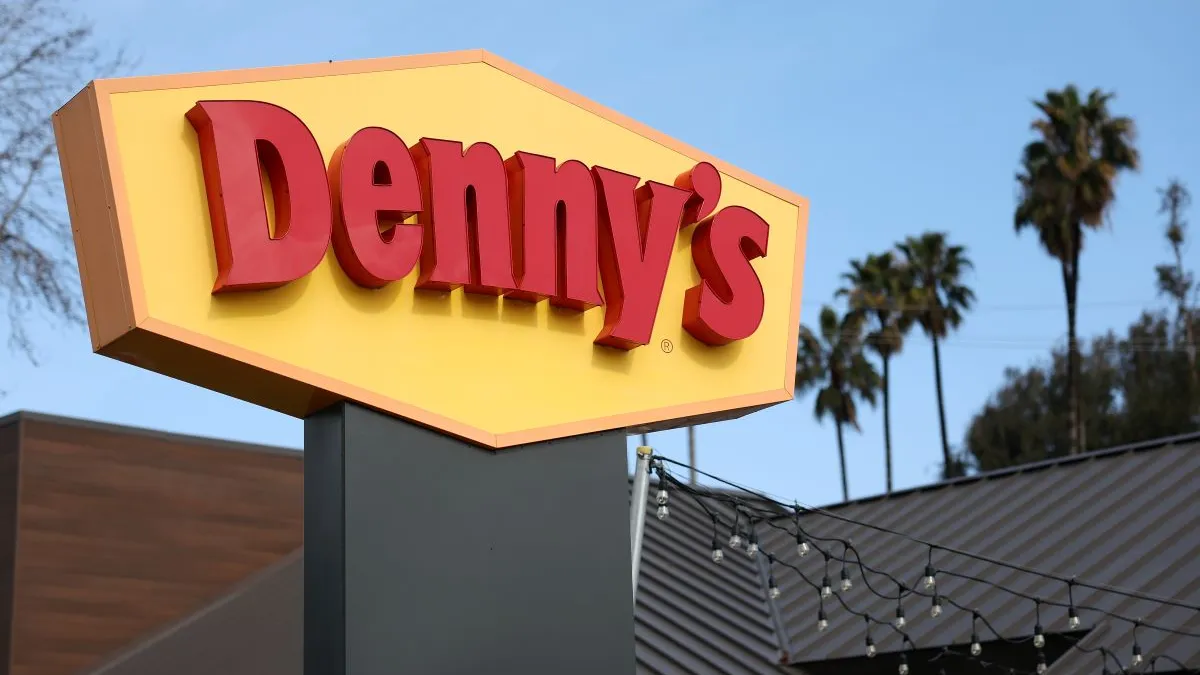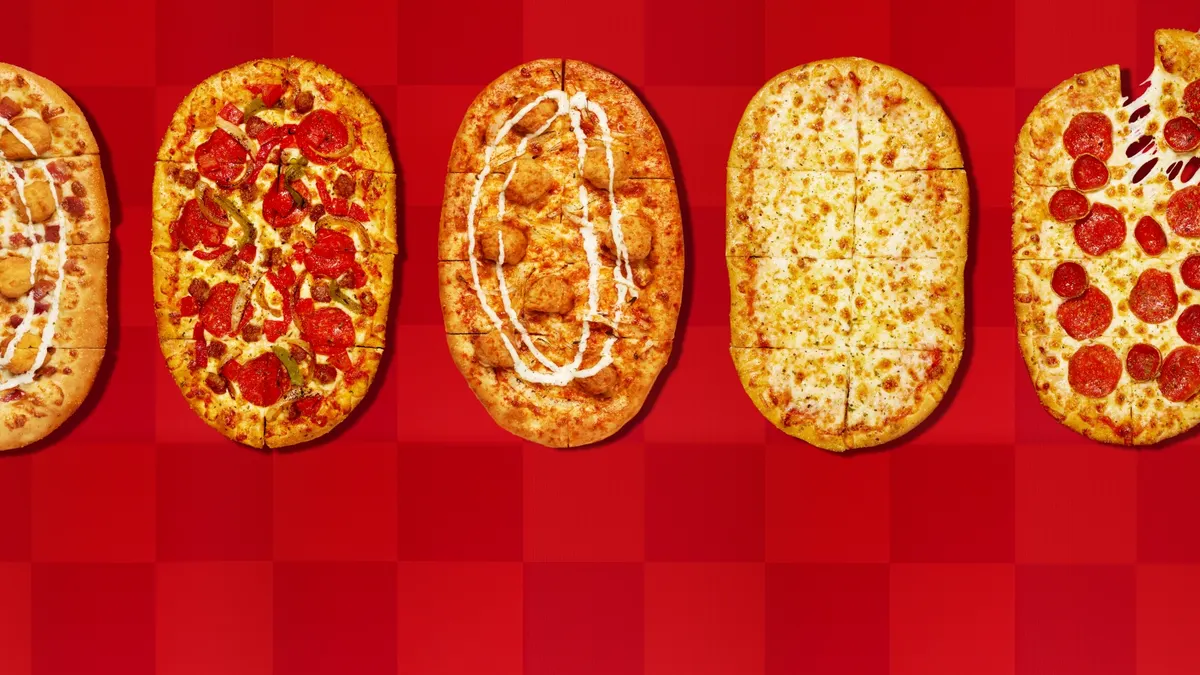For California Tortilla co-founder Keith Goldman, using fresh ingredients has always been a part of the chain’s business plan.
“The concept of fresh is very interesting to me. It’s also very frustrating to me,” Goldman told Restaurant Dive. “A lot of these brands that promote freshness, in reality, are taking frozen pre-processed food and assembling it to order and calling it fresh.”
As consumers have demanded more transparency from their food, chains have responded by offering fresh ingredients and marketing healthier options, customizing their menus to meet a variety of needs from vegans and vegetarians to paleo and Whole30 dieters and removing antibiotics from their meat. But California Tortilla, which has plans to grow to 100 locations by 2023, has been doing this all along.
The restaurant is a scratch kitchen and staff prepare 25 recipes every day, Goldman said. In addition to the restaurant’s “wall of flame” that holds 75 hot sauces with a wide range of heat levels, customers can also sample homemade sauces like California Screamin’, Sunset Sauce and Havana Sauce.
“All of these sauces add a flavor boost,” he said.
Committing to freshness for California Tortilla means not having freezers. Proteins are delivered every two to three days and produce is delivered every day, Goldman said. Kitchen staff cook items in small batches to keep things like salsa and guacamole fresh.
“Buying frozen or prepackaged foods have other things in them, like preservatives and other ingredients ... that you can’t even pronounce,” Goldman said. “We don’t have anything in our products. That is where the health comes from. People hear fresh, they want clean food.”
Other chains are trying to make their ingredients fresher, better tasting and more clean label, but switching up ingredients doesn’t happen overnight. Wendy’s and McDonald’s are moving away from antibiotics in their beef supply, while Chick-fil-A has already done so with its chicken. McDonald’s previously said it was moving away from preservatives, started cooking quarter pounders with fresh beef and also removed antibiotics from its U.S. chicken supply.
The supply chain has to adapt alongside restaurants, and McDonald’s move will take several years. The burger giant is currently expected to create reduction targets for medically important antibiotics from its top 10 beef sourcing markets in 2020.
“When McDonald’s moves on something, it can change the entire supply chain for the rest of restaurants,” BTIG managing director and restaurant analyst Peter Saleh told Restaurant Dive.
Customization can help fresh ingredients shine
In response to growing consumer interest in fresh and nutritious options, many chains have also been pushing toward greater customization to make sure customers can get exactly what they want. When Panera introduced kiosk ordering, the number of customized orders increased, according to Saleh.
“What restaurants are finding as they transition more customers to digital orders, more of those orders become customized since customers are taking more time to look through the menu and maybe want to add this or that,” Saleh said.
Customization also offers an opportunity for restaurants to charge more, he said. Many companies tack on an additional charge for gluten-free options, for example. Customizing via digital channels also allows restaurants to save on labor productivity, Saleh said.
“Growth in customization is going to be very rapid and that will continue for the foreseeable future,” Saleh said. “More customers transitioning to digital makes it easier to have exactly what [they] want rather than [ordering] these standard menu items.”
Chipotle’s Lifestyle Bowls, for example, came about after the chain noticed that guests were creating their own diet-specific bowls, such as keto, paleo and Whole30, when ordering at the restaurant. The company wanted to make placing those orders easier for customers buying online, Chipotle senior director of external communication Erin Wolford told Restaurant Dive in an email.
In just a few days, the menu innovation generated 1.3 billion earned media impressions, CEO Brian Niccol told investors during the Q4 2018 earnings call.
To offer more customization, California Tortilla has started rolling out assembly-line style preparation alongside its traditional menu in a few new restaurants this quarter, where people can pick and choose their flavors.
"The idea is to have a good hybrid,” he said.
The downside to the build-your-own model is that customers may combine flavors that don’t really belong together, but the staff is knowledgeable on what flavors work together and let customers know that the end result might not taste good, but will leave it up to the customer to decide, Goldman said.
How brands are telling fresh stories
Healthier options are increasingly important to consumers and Chipotle has been a prime example of a national brand bringing nutrition to the spotlight, but being healthy wasn’t always a standard for quick service, Saleh said.
Fast food has long been thought of as unhealthy, but consumer demand, especially coming from millennials and aging baby boomers, has shifted toward healthier options, especially with the growth of healthy fast food chains, like drive-thru Salad and Go, and that has also meant using fresher ingredients.
Like California Tortilla, Chipotle doesn’t use freezers or microwaves and prepares its food daily, Wolford said.
“We are transparent with our ingredients and our preparation process,” she said. “Chipotle has always been known for deep customization and real ingredients so our customers understand that for us it isn’t a trend, it’s our mission.”
Chipotle recently stepped up its marketing initiatives to highlight its use of fresh ingredients after several food safety stumbles.
The fast casual chain’s For Real marketing campaign, which launched in September, showcased Chipotle’s ingredients and cooking techniques and provided significant awareness about the brand, Niccol said during a recent earning call. The restaurant also increased its marketing budget by 4.2% during the quarter, which funded both this campaign and its free delivery bowl campaign in December, Niccol said during the call.
“Chipotle has always been known for deep customization and real ingredients so our customers understand that for us it isn’t a trend, it’s our mission.”

Erin Wolford
Chipotle senior director of external communication
The company expects to invest in the low to mid 3% range toward marketing and ads during the current quarter — which will include the launch of its Beyond the Foil campaign — compared to the 1.8% it spent during the first quarter of 2018. The new campaign will be a lot like a documentary instead of traditional advertising, Niccol said on the call.
“It showcases our fresh ingredients, food preparation and celebrates the work of our talented team members do everyday in our restaurants to provide our guests a great dining experience,” he said on the call.
To distinguish itself from other restaurants that center their brands and marketing around fresh offerings, California Tortilla’s philosophy is called Flavor Rules, which is the company’s commitment to how it prepares its items to make sure they taste the best.
“We think that when you use fresh ingredients and prepare them at more frequent intervals, the flavors pop,” he said.
That means making sauces and guacamole every few hours to capture the best flavor.
“Flavor rules. That’s our goal. It adds a little edginess,” Goldman said. “We go out of our way to do things a little more. We’re passionate about flavor.”
As part of its marketing the use of fresh ingredients, it set up exhibition kitchens in some of its locations so that customers could see how the food is prepared. Even though the food was made exactly the same way as its regular kitchens, customers felt it tasted better, he said.
Many customers didn’t know California Tortilla used fresh ingredients, and making the connection seemed to have an impact, Goldman said.
“You can say fresh, but when people see it, they tend to believe it more,” he said.
Fighting food safety issues
While more fresh ingredients garners consumer interest, it also yields additional food safety risks — some of which may be unavoidable.
“I don’t think there is any way to eliminate food safety risk unless you cook all the food,” Saleh said.
Many restaurants do have processes where they test a sample of produce to see if it is contaminated and will throw out the batch and start over if it is, Saleh said.
Last year’s romaine contamination events proved that restaurants need a backup plan if the entire supply chain of a fresh ingredient is cut off. At the same time, restaurants also need to have a plan in place to make sure that the produce and food they receive is fresh and safe.
“I don’t think there is any way to eliminate food safety risk unless you cook all the food."

Peter Saleh
BTIG managing director and restaurant analyst
Chipotle learned this the hard way after having a handful of romaine contamination incidents in 2017 and 2018. Following the 2017 incidents, the company’s sales slid. It also hired Brian Niccol last February to help revamp its image. Under Niccol’s leadership, the company responded quickly to another event that occured in 2018 and implemented a Chipotle Field Leadership team to retain employees on food safety. It also built out a supply chain team to help improve food safety issues.
Chipotle has also adopted quarterly food safety training, where crew members are training on how to keep food safe, CEO Brian Niccol said during an investor call.
Increased marketing spend, a clearer strategy for food safety issues and better brand awareness paid off. Chipotle increased revenue 8.7% to $4.9 billion in 2018 and grew comparable sales by 4% during 2018.
Given its lack of freezers, California Tortilla works closely with its food vendors to make sure it has the freshest products possible and that it has an appropriate amount of shelf life left on products when it is received, Goldman said.
California Tortilla also has a “just-in-time program” set up with its chicken provider, meaning the vendor waits until all the stores in the chain have made their chicken orders for the following day, Goldman said. Once received, they work during the night to prepare the chicken to the specifications and send it out on morning trucks, Goldman said. The cases of chicken are stamped with production dates so staff know how long they have to use the chicken, he said.
Managers and operators are also trained on how much to properly order and become certified safe food handlers through the ServSafe program, Goldman said. The program is a food and beverage safety training and certificate program from the National Restaurant Association.
Flavor is still king
While California Tortilla remains committed to serving fresh, healthy ingredients, it also keeps an eye out for the current flavor trends when it considers adding a new menu item. For example, a few years ago, Korean barbecue was a popular flavor and it happened to have a profile that would fit with California Tortilla’s existing flavor, Goldman said. After doing some R&D and getting feedback, California Tortilla made Korean barbecue tacos and burritos a three-month LTO and it proved to be popular enough to add to the menu, he said.
Chipotle too has experimented with new flavors, such as queso and chorizo. Queso was added to the menu in 2017 after customer’s kept asking for the addition. But many were disappointed with the recipe calling it “dumpster juice,” according to Business Insider. The chain modified the recipe, and it seemed to help. During the second quarter of 2018, Chipotle increased same-store sales by 3.3%, in part due to increased demand for queso. The item also led to a 2% increase in average checks. It also added chorizo to its menu previously, but for a limited time.
California Tortilla will bring items back to the menu depending on seasonality, such as its bangkok shrimp taco that is a popular summer item, Goldman said. It has also tried Cubana bowls, chicken tikka masala flavors and mediterranean flavors.
“We’re not afraid to try anything,” he said. “There’s not too much risk involved in running an LTO. … If people take to it, it’s a candidate for the next menu.”





















